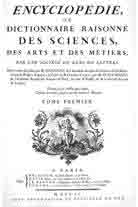Introduction
It was a century of political revolutions, The American Revolution ending in 1776 in which American colonists waged war for independence from their English forefathers, and The French Revolution, led by Napoleon, against the autocratic regime and conspicuous consumption of King Louis XVI and his wife Marie Antoinnette.
Associated with revolutionary activity were calls for individual human rights, the best known among them being that of Thomas Paine’s (1737-1809) whose ideas appeared in his small and powerful book The rights of man.
It was also a century dedicated to new ideas, to progress, and to the gathering and organizing information about the natural world through scientific experimentation. There was a large expansion in the educated middle class--people who were wanting to learn about the universe and to critique and reflect on what they learned. There was a popular demand at the time for encyclopedias, dictionaries, and detailed surveys of knowledge. The 18th century came to be called by historians the age of enlightenment.
Among the key players in the Enlightenment movement were the French writers and philosophers Denis Diderot (1713-1784), Voltaire (1694-1778), Montesquieu (1689-1755), and Jean-Jacque Rousseau (1712-1778). These men were among those called philosophes, whose writings reflected on as well as contributed to their times. Among the most famous of the philosophes’ writings was an encyclopedia, edited by Denis Diderot compiled between 1751 and 1772—a book that contained seventeen large volumes of information about the natural world and its history. The Encyclopedie became a widely read and cited compendium of scientific, technical, and historical knowledge.

Another effort during the period of Enlightenment, and one that followed directly from Francis Bacon’s inductive approach to science, was the move to identify and classify objects. Carl Linnaeus (1707-1778), a Swedish botanist who developed an elaborate system for subdividing plants into genus, species. He published his system in 1735 in a book called Systema Naturae. It consisted of a taxonomy of eleven pages, that served to classify 4,400 species of animals and 7,700 species of plants. The system had multiple nestings, including kingdoms, class, order, genus and species. The genera and species divisions, such as the classification of homo sapiens for human beings, has withstood the test of time. It is today dubbed binomial nomenclature.
In 18th century England as part of the enlightenment’s effort to understand and control the natural world, there was a move to regularize, and valorize the English as a language. The most notable and influential example of this trend was the dictionary/encyclopedia of Samuel Johnson, published in 1775. Johnson’s Dictionary of the English Language, had a far-reaching impact on the development of English lexicography and dictionary-making and both reflected and contributed to the efforts of enlightenment readers to understand the world around them. Johnson’s dictionary was the definitive source for the English-speaking world a century and a half later when it was supplanted by the larger and less colorful Oxford English Dictionary.
Meanwhile in America, following their gain of independence in 1776, the founders began to unify the country and create a single identity out of the separate colonies. As the patriots developed their new country’s identity, they also formed new personal identities for themselves—identities that were intertwined with their public speaking abilities. There was considerable emphasis by these early Americans on learning to speaking well, as is indicated by the heavy emphasis on elocution and rhetoric in school curricula. There was also a strong movement to create uniform speaking standards. Further many public speaking venues were created throughout the country where orators, politicians, and clergy proselytized and entertained.
During this period, the efforts made to improve the speech of people with speech problems was often indistinguishable from the general societal aim that everyone could and should improve their speech through training and practice. Our 18th century ancestors, therefore, became engaged in teaching rhetoric and elocution in the public schools and the universities with the aim of improving the speech of everyone, including those with communication disabilities.
Our ancestors were also involved in studying medicine as a natural experimental science. Benjamin Franklin (1706-1790) worked to discover ways to alleviate medical conditions such as apoplexy, an 18th century term for stroke. And Benjamin Rush (1745-1813), one of the 56 signers of the Declaration of Independence, was among those who working to create logical classification systems for diseases.
At the end of the 18th century there was considerable interest in the impact of socialization on children. Jean Jacques Rousseau (1712-1778), for example, considered infants and young, unsocialized children as inherently good. He argued that civilization and the desire for property was what created avarice in people and corrupted them. For this reason, children who were not subject to ordinary socialization processes, such as those with disabilities, were treated as natural experiments for learning about how environment can impact learning and form character. This concern about nature vs. nurture that was raised by Rousseau provided the French physician Jean Marc Gaspard Itard (1775-1838) with the intellectual challenge of civilizing Victor, a boy found in the wild.
Our 18th century forefathers would neither have identified themselves as speech pathologists nor as speech correctionists. Rather, they would have seen themselves as medical researchers and practitioners or rhetoricians or educators. What follows is a review of what happened in the 18th century that had bearing on what was to become the field of speech-pathology. The review will be divided into four general sections, one on medicine, one on rhetoric, one on disability and one on education--including special education and education for those with communication disabilities.
